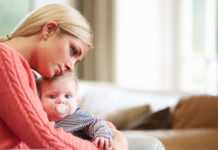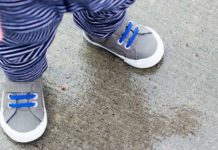Podiatrist Dr Samuel Ong (B. Pod. Med.) is the founder and principal podiatrist of Mustard Seed Podiatry.
How are baby’s feet not just smaller versions of adult feet and do they need to be treated in a different way?
As a newborn, feet are mostly cartilage, with the last bones not formed until up to the age of five. Only after all of the bones are formed will they start to resemble a smaller version of an adult foot. Children’s feet continue to grow until they are around 18 years at which stage most of the bones have fully developed. Given these differences, baby shoes are not required and babies should not be wearing shoes as they can be restrictive to growth.
When should babies start wearing shoes?
Babies start to walk between 9 and 12 months, with most walking by 18 months. When your baby first starts walking, baby shoes are only required to protect their feet against sharp objects, dirt and slippery surfaces while outdoors. Fancy features are not required in the shoes.
Babies younger than this don’t really need baby shoes as they are not walking. The main thing is to keep their feet warm in the cooler weather. Onesies (playsuits) with feet, socks, booties, and soft baby shoes are adequate for keeping little feet warm.
What to look for in socks for babies?
When it comes to socks, make sure they are properly fitted. The socks should not be too tight as tight socks can restrict circulation and growth of the feet. This goes for onesies too, make sure that the foot is not too tight even if the rest of the suit fits. If this is the case, go up in size to make sure the feet are not restricted.
With regard to the material, go for a natural fibre material like cotton or wool for their moisture absorbency. Cotton keeps the feet cool so it is more appropriate for the summer, while wool keeps the feet warm and is more suited for the winter.
Why are there so many options for baby shoes if they are not recommended?
 I think that there are two main reasons why there are so many options for baby shoes. The first is the fact that companies are trying to capitalise on a previously untapped market. In the past, babies and toddlers never wore shoes and as such there were few shoes made for them. Shoe companies realised this gap in the market, and started to make shoes for babies while trying to educate parents on why their baby needs shoes. Many businesses can portray misleading or incorrect information in order to sell their shoes.
I think that there are two main reasons why there are so many options for baby shoes. The first is the fact that companies are trying to capitalise on a previously untapped market. In the past, babies and toddlers never wore shoes and as such there were few shoes made for them. Shoe companies realised this gap in the market, and started to make shoes for babies while trying to educate parents on why their baby needs shoes. Many businesses can portray misleading or incorrect information in order to sell their shoes.
The second reason involves parents asking or pressuring shoe companies to make shoes for their babies. However, instead of buying unnecessary shoes when your child is a baby, parents should save their money for shoes when the child is older.
Can wearing shoes cause damage to babies’ feet? How?
A link between wearing shoes and damage to babies’ feet is still unproven as there is currently not enough research being done in this area. However, many experts believe it is better for babies to be barefoot as it improves sensory feedback. This helps them to develop their proprioception (their awareness of their body in relation to space). In addition to this, going barefoot allows better development of the muscles and ligaments in their feet.
Should parents be concerned about flat feet in babies?
No, parents shouldn’t be concerned about flat feet in their baby. Most, if not all, babies’ feet will appear flat. Babies’ feet are mostly made up of cartilage with lots of fat padding, so it can give the appearance of flatness.
Are there any abnormalities or issues parents should look out for in their baby’s feet?
Yes, parents should always be on the look out for changes in their babies’ feet. In particular, clubfoot, metatarsus adductus, and toe deformities. If a baby has clubfoot, their foot/feet points downwards at the ankle, while the heel and foot turn inwards. Clubfoot would normally be diagnosed by a doctor at the hospital after the baby is born, and it can even be diagnosed by ultrasound before the baby is born.
In metatarsus adductus, the forefoot is turned in, relative to the rearfoot. Metatarsus adductus can be diagnosed after the baby is born.
Parents should also look out for toe deformities such as polydactyly, syndactyly and overlapping toes. Polydactyly is where the baby has an extra toe, and syndactyly is where the baby has webbed toes.
Summary
- Babies’ feet differ markedly from adult feet and as such should be treated in a different way
- Babies who are not yet walking do not need to be wearing baby shoes as it can be restrictive to growth of the feet
- Parents do not need to be concerned about flat feet in their baby but they should look out for any abnormalities such as clubfoot, metatarsus adductus, and toe deformities.
- If parents have concerns about their baby’s feet, it is best to seek advice from a podiatrist.



 (4 votes, average: 4.00 out of 5)
(4 votes, average: 4.00 out of 5) 






